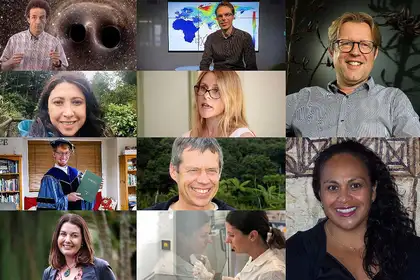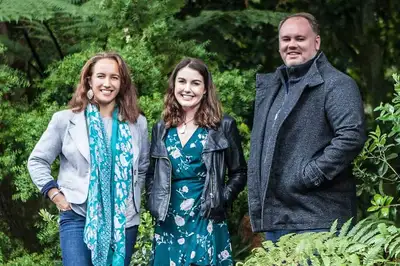
Clockwise from top left: Professor Joachim Brand, Professor Murray Cox, Professor Jeroen Douwes, Dr Andrea Clavijo-McCormick, Dr Katherine Holt, Dr Wesley Webb, Professor Mick Roberts, Dr Ridvan Firestone, Dr Rochelle Stewart-Withers and Dr Nikki Freed.
Ten Massey University-led research projects will receive almost $9 million from the Royal Society Te Apārangi annual Marsden Fund announced by Research, Science and Innovation Minister Dr Megan Woods.
The projects – seven standard grants and three “fast-start” grants for new and emerging researchers – include understanding how pathogens spread in a pandemic, unlocking UV-B radiation in pollen, navigating Pacific knowledge and practices in relation to diet, and understanding female birdsong.
This year, only one Marsden Council Award grant was awarded, and for the first time Massey University was the successful recipient, with a $3 million grant 'Biodiversity, microbiota, and childhood allergies and asthma: variation across space and time' going to the Research Centre for Hauora and Health.
Director of the centre and lead investigator, Professor Jeroen Douwes, says it is considered the most prestigious of all Marsden grants, and is delighted the centre and Massey have received the award.
The Research Centre for Health has also received a Marsden Project Grant ($870,000) for a research project led by Dr Ridvan Firestone.
Vice-Chancellor Professor Jan Thomas says the results show the university continues to flourish with talented researchers whose work is not only crucial to the environment we live in but is world-leading.
“Here at Massey, we have a strategic goal in relation to research and the Marsden funding this year is once again proving we are excelling at this through our research connections with industry and community. We take pride in our efforts to solve national and global problems, and I know these projects, supported by the fund, will continue to serve communities and bring to light new knowledge, vital to our world.”
Marsden Council Award
Biodiversity, microbiota, and childhood allergies and asthma: variation across space and time - Professor Jeroen Douwes. Other principal Massey investigators include Professor John Potter, Associate Professor Andrea ‘t Mannetje, Dr Collin Brooks, Dr Marine Corbin, Professor Chris Cunningham and Dr Caroline Shorter and Professor Julian Crane (University of Otago). $3 million.
Aotearoa has amongst the highest rates of asthma and allergy in the world, with Māori and Pasifika disproportionately affected. Asthma sufferers cannot be cured - only the symptoms can be managed. This is because we do not yet have a clear understanding of what triggers asthma development.
This study will explore whether loss of environmental biodiversity and reduced access to green space are linked to differences in New Zealand children’s gut microbiota, and consequently to the development of asthma and allergy. They will also investigate whether changes in gut microorganisms over time are associated with these factors. Finally, they will compare samples from asthmatic and non-asthmatic children in Aotearoa, Ecuador, Brazil, and Uganda to determine whether there are differences in human microbiota between different countries, which could account for the high asthma rates seen here.
Professor Douwes says "This study will explore the mechanistic role of biodiversity and microbes and their multiple interactions in the causation and prevention of asthma and allergy with the specific aim of increasing understanding to the point of being able to test new whānau- and community-based prevention strategies. This highly novel approach will facilitate the development of effective interventions to reduce the considerable asthma burden, particularly in New Zealand, as well as globally."
Standard Fund
Unlocking centuries-worth of surface UV-B radiation history hidden in pollen- Dr Katherine Holt, School of Agriculture and Environment. $944,000.
UV-B radiation is harmful to both humans and the biosphere. Since the discovery of the Antarctic Ozone Hole, we have been very aware of how the intensity of UV-B radiation reaching the Earth'
surface can change on short (annual to 10-yearly) timescales, especially here in New Zealand.
But how has UV-B flux changed in the more distant past?
Dr Katherine Holt says knowing the answer to this is crucial for predicting how UV-B might change in the future.
In their project, they will use ancient pollen preserved in lake sediments from New Zealand and Turkey to investigate how the amount of UV-B radiation reaching the Earth's surface has changed over recent centuries and millennia.
Unravelling the 3D structure of archaic hominin DNA in the human genome. Professor Murray Cox, Fundamental Sciences. $966,000.
Modern humans have inherited as much as eight per cent of their genome from extinct hominins, with the highest frequencies of Neanderthal and Denisovan DNA today found in the Pacific region. This ‘archaic’ DNA is enriched for immune pathway genes and regulatory elements, and clusters non-randomly across the genome in a pattern characteristic of the co-associating domains that form during 3D folding of DNA in the nucleus.
Professor Cox says our knowledge of how archaic DNA interacts in 3D space, and how it influences gene expression remains poorly understood.
By identifying the interaction networks of archaic regions, we will generate the first real understanding of how archaic DNA functions within cells, influencing phenotype in humans living today. With genetic research heavily biased towards Europeans, this study will stimulate improvements in the genomic healthcare of Māori and Pacific peoples, while addressing a fundamental evolutionary question: what does the DNA we inherited from archaic hominins actually do?
Our game by our rules: Bringing an Indigenous perspective to the Sport-for-Development (SFD) field. Dr Rochelle Stewart-Withers, (Te Āti Awa) School of People, Environment and Planning, Dr Farah Palmer (Ngāti Maniapoto, Waikato) School of Management and Dr Jeremy Hapeta (Ngāti Raukawa, Ngāti Huia) School of Sport and Exercise. $870,000
“Despite 20 years of dedicated Sport-for-Development (SFD) theorising, research and practice, Indigenous worldviews remain silenced and positioned at the margins. This is deeply concerning as Indigenous people are frequently the target of deficit-focused SFD initiatives, while at the same time being excluded in decision-making,” Dr Rochelle Stewart-Withers says.
Using Kaupapa Māori methodology and the Fijian Vanua framework, case studies will be conducted in Aotearoa and Fiji to shine light on SFD initiatives which are informed by Indigenous viewpoints and align with Indigenous aspirations.
The project will carry out observations and in-depth interviews with groups involved in rugby, Iron Māori and outrigger canoeing.

Dr Farrah Palmer, Dr Rochelle Stewart-Withers and Dr Jeremy Hapeta.
Three atoms in a tight spot. Professor Joachim Brand, NZ Institute of Advanced Studies. $939,000.
When three cold atoms are brought into proximity, they may collide and form a molecule, or keep their distance. Professor Joachim Brand will explore the rules of a potentially chaotic motion in such atomic triads and whether it is possible to manipulate the atoms in a way that they never meet, and molecule formation is suppressed.
“We now have unprecedented capabilities to assemble, manipulate, and observe three-atom systems in optical tweezer traps at the single event level, but are still lacking theoretical insight. Motivated by unexplained experimental data and building on our recent success in reducing the complexity of quantum simulations with the trans correlated method for ultra-cold atoms, we will develop new simulation tools to aid our understanding of few atom dynamics in optical tweezers accounting for realistic experimental conditions.”
The purpose of this project is to understand how far this prediction holds up under realistic conditions. How can an expected transition to quantum chaos be monitored and manipulated or mitigated while building up correlated phases of matter, atom by atom? Their theoretical predictions will be tested in experiments with ultra-cold atoms in optical tweezers.
The dynamics of interacting infections. Professor Mick Roberts, School of Natural & Computational Sciences. $491,000.
The COVID-19 pandemic originated when the SARS-Cov-2 virus emerged from an animal reservoir to infect humans. Pathogens (viruses, bacteria, parasites) have been described as ecological dark matter, always present in ecosystems but often overlooked. Changes in land-use and climate are bringing pathogens that infect animals into closer contact with humans, and on occasions an infection jumps species.
Professor Roberts says this research will include using mathematical models to describe how pathogens interact with their hosts and all other species in an ecosystem, including other pathogens.
“We will explore how changes in ecosystem biodiversity affect the spread of infection, and how competition between pathogens changes the ecosystem balance. Our results will improve understanding of the relationship between biodiversity and the spread of infectious diseases; and provide criteria for when a pathogen is more likely to infect a new host species.”
They will also develop a model for the progression of an infection within a single host, and the interaction between multiple infections. They will then apply this model to seasonal epidemics of influenza viruses and coronaviruses.
“We will demonstrate how interacting virus strains generate complicated dynamics and how emerging pathogens can become established leading to pandemics.”
Navigating Pacific Indigenous knowledge and practices in relation to contemporary dietary patterns: investigating 'ai ia e ola' - eat to live well. Dr Ridvan Firestone, Ms Hana Tuisano, Research Centre for Hauora and Health. $870,000.
Dr Ridvan Firestone and her team will look to better understand the link between ‘culture and food systems, diet and traditional practices’ and ‘diet-related diseases’ such as diabetes, particularly from a Pacific worldview.
The central question driving this research: What insights are contained in indigenous and traditional knowledge systems that can be used to design new ways to prevent diet-related diseases amongst Pacific peoples in New Zealand?
She says this research will develop a theoretical model of Pacific dietary patterns that will be culturally-centred, by investigating the historical and social-cultural perspectives on lost and evolved indigenous and traditional knowledge, and dietary patterning, in relation to diet-related diseases.
Fast-Start
Predicting evolution: Quantifying the emergence of antibiotic resistance in diverse environmental strains of E. coli - Dr Nikki Freed, Dr Olin Silander, School of Natural and Computational Sciences. $300,000.
Dr Nikki Freed’s project will look at how an organism adapts when it encounters a new environment, which is important for our understanding of many different topics in biology – from speciation to human health.
“We will test how genotypic similarity influences predictability using experimental evolution with a range of highly-diverged members of the same species; investigating, on a massive scale, precisely
how diverse E. coli strains evolve antibiotic resistance. Our preliminary results indicate there are marked differences in how evolutionarily diverged isolates of E. coli evolve resistance to antibiotics. We will investigate this using cutting edge tools in genome sequencing and laboratory-based evolution.”
Understanding the evolution of complex female song in songbirds. Dr Wesley Webb, Professor James Dale, School of Natural and Computational Sciences. $300,000.
Dr Wesley Webb says elaborated traits, or 'ornaments'—such as complex songs and colourful plumages in songbirds—play a key role in animal communication.
“How female ornaments have evolved is poorly understood in general; moreover, nothing is known about the evolution of female birdsong complexity. Here we propose an in-depth analysis of the evolution of female song complexity across the songbirds.”
Plant communication in times of rapid environmental change. Dr Andrea Clavijo-McCormick, School of Agriculture and Environment. $300,000.
Dr Andrea Clavijo-McCormick says the spread of invasive species is one of the leading contributors to rapid environmental change in New Zealand. These species drastically modify the environments they invade, with devastating consequences for native communities.
This study aims to compare the chemical language of two alien weeds, heather and Scotch broom, in their native (UK) and invasive (NZ) ranges. This work will advance their understanding of plant communication allowing us to predict the impacts of rapid environmental change on native species' communication networks.